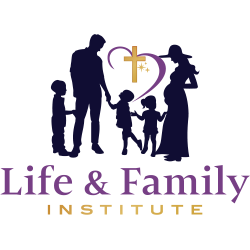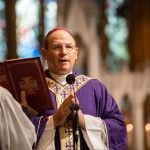Homily given by Bishop Anthony Randazzo
Mass for the Unborn (Sunday 3 Lent C)
Saint Mary’s Cathedral, Sydney
In recent weeks, I have been at various meetings with Archbishop Fisher, and I have noticed that when we pray His Grace has called upon the intercession of Our Lady of Sorrows.
It has caught my attention because, when I think of the many encounters that I have had with our Archbishop I think of joy, not sorrow. I know that there is a logical reason why he chose the sorrowful Mother as intercessor, nevertheless my curiosity remains.
I am, of course, impelled during this season of Lent, to think of that poignant image so well described in the Stabat Mater, the most famous Marian hymn composed in Latin in the thirteenth century.
Stabat Mater dolorosa
The sorrowful Mother was standing
iuxta Crucem lacrimosa
and weeping alongside the cross
dum pendebat Filius.
on which her son was hanging.
The sorrowful Mother was standing alongside the cross. And I suspect that here might be hidden the key to unlock my curiosity. Because, the cross is the source of all our joy! There is no mistaking that death on a cross was agonising. There is no avoiding the pain and humiliation. For someone without faith, it is simply futile and shameful!
Yet, we Christians hold the cross in honour. The crucifix has a different message. As Saint Paul insists, for those with faith it is a sign of God’s love – a God who loved the world so much that He sent His only Son so that the world might have life to the full cf. Jn 3:16; 10:10.
The cross also conveys Divine power. God raised up Jesus from death and opened for us a way beyond this earthly life to eternal life with God. By uniting ourselves with the suffering one, our own suffering can be destroyed. By taking up the cross, we follow Christ, who walked in the midst of many difficulties to face the challenge that lay before him. By uniting ourselves to the holy one, our own holiness can be restored!
Unless one sees and believes in the Divine power of God, the cross will appear as foolishness and the resurrection will seem impossible. To understand the cross, it is essential that we turn to the Gospels. When Jesus spoke of his suffering, death and resurrection, the disciples were terrified and they were confused Mk 8, 27-38. They were empty, with a great feeling of nothingness inside of them.
They did not understand Jesus’ words about the cross, because they were not capable of understanding or accepting a Messiah who became the servant. Rather, they continued to dream of a glorious Messiah. When Jesus announced his Passion and Death, they discussed who among them would be the greatest. Jesus wants to serve, they only think of commanding! Ambition leads them to promote themselves at the cost of Jesus.
For Jesus, the Cross is no secret nor is it an optional extra. It is essential. Jesus spends much time and energy forming his disciples, and he speaks with them about the Cross. He says that according to the prophecy of Isaiah Is 53, 1-10, the Son of Man has to be handed over and condemned to death.
While He was with them, the disciples listened to Jesus, but they did not understand what he was saying about the Cross. In fairness to the disciples, such knowledge will always be imperfect this side of the grave. And yet, the search for an ever-deeper understanding of Christ crucified is life’s great adventure (Rush, 29 Nov 1991).
It was only after the resurrection, with the appearance of Jesus, that they began to see with some clarity what it was all about. And the knowledge of Jesus was uncontainable! They had to tell others, not because they were ordered to… but because knowing Jesus compels one to share that knowledge with others. It is impossible to keep the Good News of Jesus Christ to ourselves!
If Jesus did not die and truly rise from the dead, our faith would be empty and our hope for eternal life would be in vain! Where there is no expectation of life beyond the grave, then only earthly life has value. And yet, in our time there are protagonists who champion the destruction of human life at its most vulnerable stage, and by this I mean the unborn life carried in the womb of a mother.
Our first reading from the Book of Exodus recalls the self-revelation of God to Moses through the generational faith of families. The covenant God made with Abraham includes his wife Sarah; it extends to Isaac and Rebecca; embracing Jacob and Rachel; coming to fulfilment in Joseph and Mary, who brought to birth the new covenant – Jesus Christ, the Son of God.
Each and every time human life is conceived the child is a reminder of God’s love for His creation and we are reminded of His desire for our eternal life. God’s ongoing commitment to His covenant is a reminder of the sacredness of human life from conception until natural death.
My sisters and brothers, Christ crucified is the ultimate sign of God’s love for us and for the world.
For the believer, the cross does not end in the darkness of the tomb, but rather, it opens the door to Paradise. To paraphrase Saint Paul, the message of the Cross seems foolish to those who are perishing, but for us, it is the power of God who saves us. And so, as disciples of Jesus Christ, we are called to proclaim by word and deed the fulfilment of the kingdom of God in the world in which we live. As we pray for the life of the unborn today, we make concrete our commitment to discipleship in Christ. Like the sorrowful Mother standing by the cross, our lives will be transformed into the joy that comes from knowing Christ crucified, and Him alone.
For us too, the next time we meet someone who does not know about Jesus, should we not take the time to stop and tell them about Him. Our witness to Christ and our action to tell others will assist in God’s work of salvation. Moreover, in the case of the innocent vulnerable unborn child, our witness may literally save a life.






